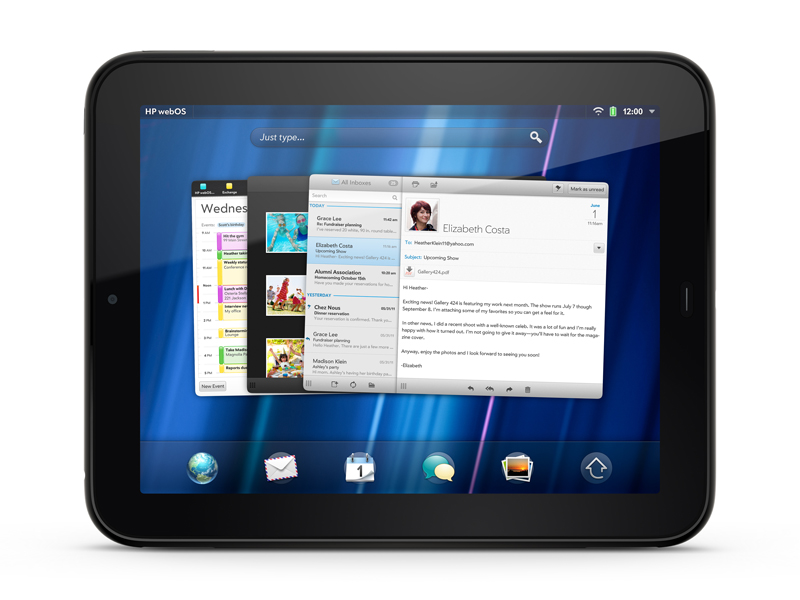TechRadar Verdict
Pros
- +
Handsome design
- +
Reasonable price
- +
Good multitasking
- +
HP Pivot is great
Cons
- -
Performance is inconsistent
- -
Screen is dim
- -
Fingerprint-tastic
- -
No video-out
Why you can trust TechRadar
When HP bought Palm, it was widely considered to have been mostly fuelled by the desire to acquire the webOS operating system.
The Pre and Pixi phones all ran the software, but after the iPad was introduced, many people had hopes that it would soon make its way to tablets.
In particular, the powerful and flexible multitasking that the Pre and Pixi were capable of was what got everyone so excited. We'll go into more detail later, but where multitasking has been something of an add-on to the iOS operating system used in the iPhone and iPad, it's always been at the core of webOS.
Check out our HP TouchPad video review:
Well, the wishes have finally been realised in the HP TouchPad, a 9.7-inch tablet running webOS 3.0. It's powered by a 1.2GHz dual-core Snapdragon processor, with 16GB or 32GB of storage. It comes in at £399 for the 16GB version and £479 for the 32GB model – a pound-for-pound match with the equivalent iPad models.
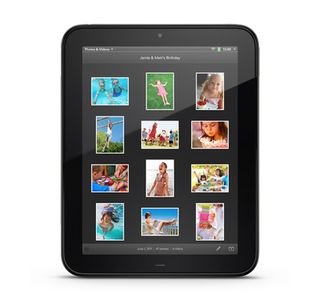
However, the TouchPad has a few tricks up its sleeve that separate it from the iPad. It's got support for Adobe Flash built in, a standard USB connector for charging or connecting to your computer, Beats Audio-powered stereo speakers and wireless charging using HP's Touchstone technology. The latter of these also allows you to simply touch the soon-to-be-released Pre 3 against the TouchPad to transfer websites back and forth between them.
Physically, the TouchPad doesn't stray far from the mould set by the iPad and adopted by the rest of the tablet world. An all-black glass front houses the 9.7-inch multi-touch screen, which has a resolution of 1024 x 768. Above it (in portrait) is a 1.3MP front-facing camera. There's no rear camera on the TouchPad.

Below the screen is a small, oblong Home button, which has a strip of light in it. This light flashes when you have a notification waiting, or stays on when you're using the device.
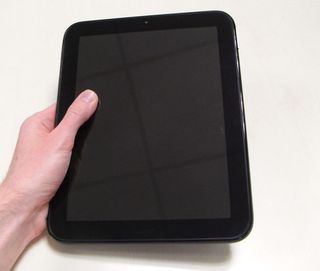
On the right-hand side of the TouchPad is a volume rocker, while the top houses the 3.5mm headphone jack and the Lock key which doubles as the on/off button.
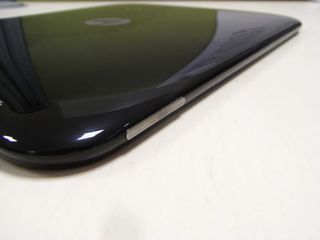
The left-hand side has no buttons, but has the stereo Beats Audio speakers, the idea being that you'll generally hold the TouchPad in landscape when these are in use. On the bottom is the micro USB port.
Although it takes many design cues from the iPad, the main difference is that the TouchPad has a plastic rear cover. Inevitably, this features a little more give in the build quality than the aluminium of the iPad, but it's still excellent, and well up there with the likes of the Samsung Galaxy Tab 10.1.
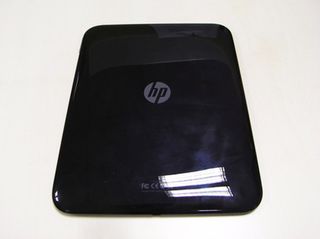
We do have some small gripes with the construction, though. The volume rocker rattles when touched, and the speaker grille holes are quite sharp, but the main one is that the glossy plastic picks up fingerprints and grease at a ridiculous rate. It can quickly become slippery and harder to hold comfortably as a result.
The same is true of the touchscreen front, and as soon as you get it into any kind of direct light, the smudges really impair your ability to see the screen. HP includes a cleaning cloth in the box that works really well, but who wants to carry that around with them all the time?
At 740g, the TouchPad is noticeably heavier than the iPad 2, but not so much as to be a make-or-break point. Obviously it is far heavier than most seven-inch tablets, such as the HTC Flyer. It's also a good 50 per cent thicker than the iPad 2, at 13.7mm, but the rounded edges mean that it's generally quite nice to hold – save for the problems we mentioned above.

The 10 best laptops of CES 2025: from the Lenovo ThinkBook Rollable to the Razer Blade 16
Australian Open LIVE: tennis stream, cheapest deals, schedule, watch every match online, draw

I am thrilled by Nvidia’s cute petaflop mini PC wonder, and it’s time for Jensen’s law: it takes 100 months to get equal AI performance for 1/25th of the cost
